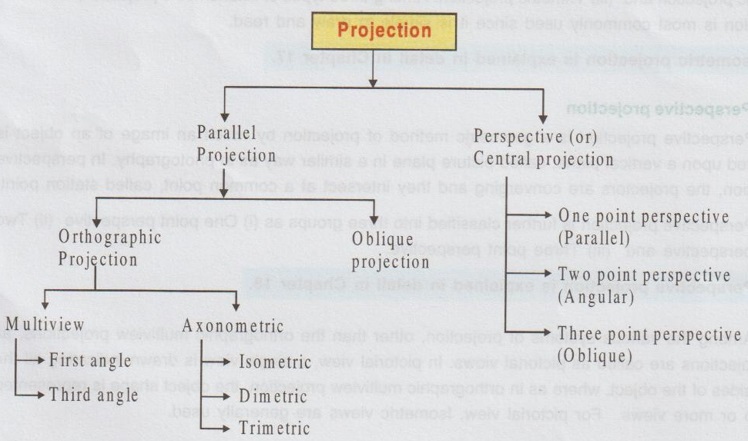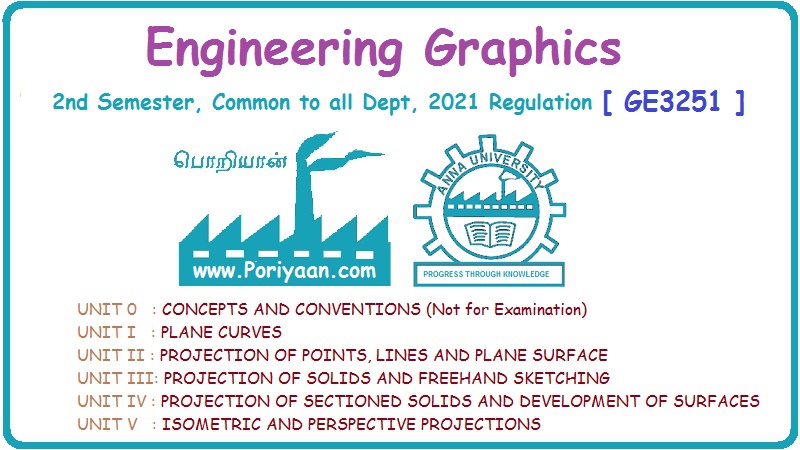Engineering Graphics: Unit I (e): Introduction to Systems of Projection
Systems of Projection
Types: Parallel and Perspective projection
The systems of projection are classified based on the direction in which the rays of sight are taken to the picture plane (drawing sheet).
SYSTEMS OF PROJECTION The systems of projection are classified based on the direction in which the rays of sight are taken to the picture plane (drawing sheet). Based on that a projection is mainly classified into two types (i) Parallel projection and (ii) Perspective (or Central projection). Parallel projection and perspective projection are further classified as detailed below: If the rays of sight (projectors) are parallel, the projection obtained is known as parallel projection. Parallel projection is further classified into two types (i) Orthographic projection and (ii) Oblique projection. In orthographic projection, projectors are parallel to each other and perpendicular to the picture plane, where as in oblique projection, the projectors are parallel to each other but make an angle, other than 90° to the picture plane. Orthographic projection is further classified into (i) Multiview projection and (ii) Axonometric projection. Multiview Projection In multiview orthographic projection the exact shape of an object is represented by two or more separate views projected on planes that are usually perpendicular to each other. Each view shows the shape of the object for a particular view direction and these views altogether describe the object completely. Hence this method of projection is most widely used in preparing engineering drawings. Multiview projections are classified into two groups as (i) First angle projection and (ii) Third angle projection. Multiview orthographic projection is explained in detail in Chapter 9. Axonometric Projection A single pictorial view which is obtained by viewing an object after turning it to get a view of its three faces simultaneously is called as Axonometric projection. Axonometric projection is a pictorial orthographic projection in which the image of an object is projected only on one picture plane. Axonometric projection is further classified into three groups as (i) Isometric projection, (ii) Dimetric projection and (iii) Trimetric projection. Among three types of Axonometric projection, Isometric projection is most commonly used since it is simple to draw and read. Isometric projection is explained in detail in Chapter 17. Perspective projection is a geometric method of projection by which an image of an object is projected upon a vertical plane, called picture plane in a similar way as in photography. In perspective projection, the projectors are converging and they intersect at a common point, called station point. Perspective projection is further classified into three groups as (i) One point perspective (ii) Two point perspective and (iii) Three point perspective. Perspective projection is explained in detail in Chapter 18. Among the various systems of projection, other than the orthographic multiview projections, all the projections are called as pictorial views. In pictorial view, a single view is drawn indicating all the three sides of the object, where as in orthographic multiview projection, the object shape is represented by two or more views. For pictorial view, Isometric views are generally used.
1. Parallel projection
2. Perspective projection
Engineering Graphics: Unit I (e): Introduction to Systems of Projection : Tag: : Types: Parallel and Perspective projection - Systems of Projection
Related Topics
Related Subjects
Engineering Graphics
GE3251 eg 2nd semester | 2021 Regulation | 2nd Semester Common to all Dept 2021 Regulation
